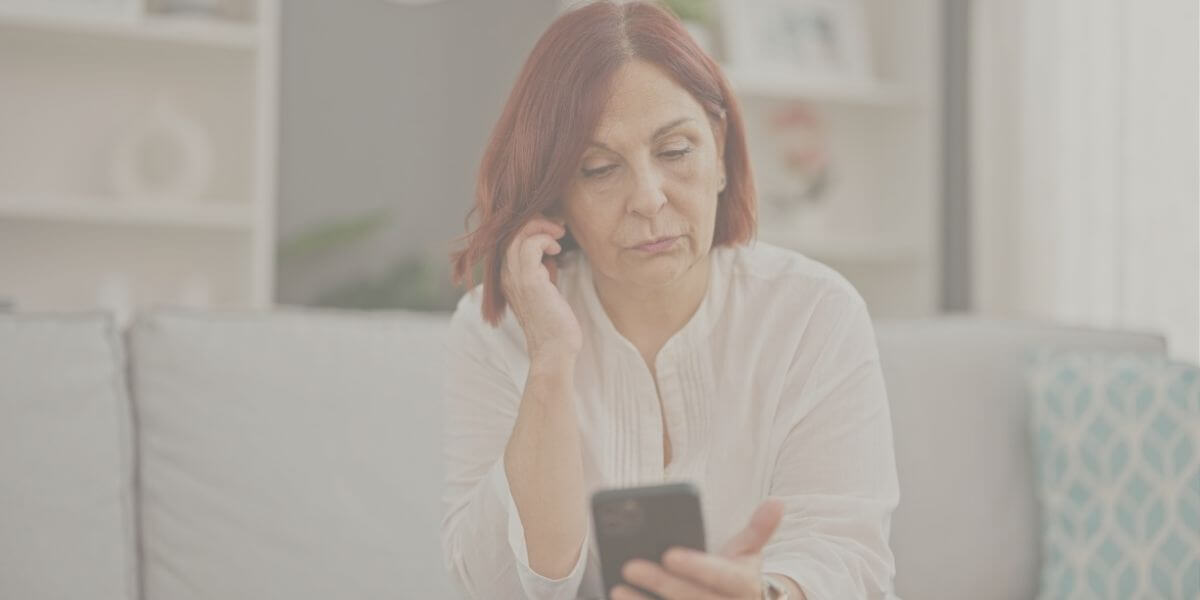Lower your internet bill
Enter your zip code to find the best deals & promos in your area.
1 Star is Poor & 5 Stars is Excellent.
* Required

Written by Rosslyn Elliott - Pub. Feb 21, 2024 / Updated Jun 23, 2025
Table of Contents
Are you happy with your Internet service?

About the author
Senior lifestyles span all activity levels. Some seniors are highly social and physically capable for their whole lives. Others may experience disability or loneliness as their social contacts shrink [1].
Across all lifestyles, seniors need internet access to fully participate in 21st-century life. So much communication now takes place through social media and websites that even in-person activities rely on digital platforms.
There’s a reason we describe people who have internet access as “connected.”
Being able to connect smoothly to most other people and organizations requires being connected to the internet. We now live in a world that is at least half digital [2]. The digital and physical worlds are not separate.
That’s why we put together this guide for people over 65. Low-cost internet for seniors does exist, and we’ll take you through all the options. You can ease your monthly budget with internet discounts for seniors while still getting all the advantages of connectivity.
It might be tempting to rely only on a smartphone for internet access. And if that’s all you can afford, that’s certainly a start.
But small cell phone screens are tricky to use compared to a laptop, with its larger monitor and keyboard. And there are some activities such as videoconferencing that are much clunkier with a cell phone than with a tablet or computer.
When you video conference on Zoom with a mobile phone, the size of the screen affects the display. You often can’t see the other participants, or can’t see them all at once.
There are other barriers to the digital world if your only device is a smartphone. Filling out long digital forms, for example, can be difficult or impossible from a phone. So ,if you need to do business or government paperwork online, and you only have a cell phone, you may run into serious frustration.

Smartphones can be too small for some uses
If you’re over 65, having home internet access with a full-sized screen and keyboard can make your life much easier. Here are some of the top ways that the internet can make a difference in a mature lifestyle:
Aging can bring you many advantages, including retirement and more leisure time. But the older you get, the more likely it is that you might find it harder to get around [3].
An internet connection eases the challenging parts of aging in ways that were never possible before.
Group socialization from the comfort of home is transformational not just for seniors but for anyone with mobility or health challenges. Video conferencing or chatting in social media groups give people companionship and support that simply were not possible before the World Wide Web.

Internet connects you to the world
If you’re on a fixed income, the average monthly cost of some types of internet may seem too steep.
But there may be cheap internet options for seniors that you don’t know about! We’ll go through some of your potential choices. And you can always enter your zip code to find providers near you.
The government offers some programs that help provide low-cost internet access for eligible seniors:

Check out the Lifeline program
One of the biggest sources of low-cost internet for seniors comes from the providers themselves.
Many major internet providers do offer senior discounts or packages that some seniors can apply for, including:
AT&T offers the Access From AT&T standard $30/month internet plan for SNAP/SSI recipients [5]. You can also qualify for the program if your total household income is below 200% of federal poverty guidelines. If the internet speed available at your home is 10 Mbps or less, you will qualify for the lower rate Access from AT&T plan, which is only $10/month.
The Spectrum Internet Assist plan is for qualified lower-income seniors and starts at $17.99/month [6]. If you receive Supplemental Security Income (SSI) and you are 65+, you qualify. You also may be eligible if you have a child living in your household who is on the National School Lunch Program (NSLP).
Optimum Advantage Internet is also for low-income seniors and includes discounted internet packages, free installation, Wi-Fi, and a router [7]. Seniors who receive SSI qualify for this program as well as any household with a child on the NSLP. The plan costs $14.99/month.
Xfinity has reduced-cost internet service plans for qualifying households through their Internet Essentials program [8]. You will get a plan cost of $9.95/month, once again qualifying either by being 65+ and receiving SSI or having a student in your household on the NSLP.
Astound features Internet First, a $10/month internet plan for those eligible for SSI, NSLP, or other public assistance programs [9].
Cox’s ConnectAssist program offers home internet service for $30/month for seniors who are receiving SSI, Medicaid, or another public assistance benefit [10].
Be sure to inquire directly with your other local providers about special rates, bundles or concessions offered to senior citizen customers to save money. Mentioning you are on a fixed income may also help secure senior-friendly internet packages and plans.

Understand your speed and data needs
Finding an ideal internet service plan boils down to balancing your connectivity needs and budget. Here are 4 tips for seniors to find affordable internet access:
When signing up for home internet services, seniors really need to scrutinize all fine print and ask providers to explain fees that may lurk below the advertised monthly rates. Be wary of:
Ask specifically about each of these cost categories when comparing plans to avoid budget-busting surprises on your first internet bill! Also ask if you can use your own purchased modem/router equipment to eliminate equipment rental fees. Finally, compare internet providers who are contract-free when possible to avoid early termination fees.
You can access internet services from your smartphone on Wi-Fi networks to avoid data overage charges.
Connect your mobile phone to your home Wi-Fi network using your wireless settings. You will be able to browse, access apps and more without relying on expensive cellular data. If you’ve never connected your phone to Wi-Fi, ask a friend or family member to show you how. It’s very easy once you’ve seen it once.
You can also limit cellular data usage on your phone to mainly just phone calls and text messages. Disable auto photo and video backups over cellular connections. Instead, manually upload those only when connected to Wi-Fi networks.
Also be sure to inquiry about senior mobile phone plans from carriers like AT&T, Verizon, Spectrum, and local providers. These plans offer affordable monthly rates.

Free public Wi-Fi
Coffee shops, restaurants, hotels and airports often provide customers with free public Wi-Fi hotspots. Connecting to these public networks with your laptop, tablet or mobile phone allows you to access internet services without using up your cellular data allowance.
Before accessing financial, medical or other sensitive accounts on public Wi-Fi, use a VPN (Virtual Private Network) service to encrypt your connection for greater privacy and security.
In some cities, local governments or non-profits also offer free community Wi-Fi networks installed outdoors in public parks and downtown areas.
If you have to do something online that really needs a computer and keyboard, don’t forget that your public library will offer computer access as well as free Wi-Fi.
Learning internet basics helps seniors (or anyone!) benefit from growing connected technologies:
For more guidance, check out our guide to using the internet for beginners in our resource library.

Internet beginners can stay safe online
Are you an internet beginner over 65 who is just getting started with social media apps like Facebook, Instagram, TikTok and more? Choose one platform to focus on first before expanding to others.
Ask a trusted relative or friend to help download the app to your smartphone, tablet, or computer device. Have them walk through initial app setup with you, creating your user profile and finding some accounts to follow.
Be careful not to share sensitive personal information publicly on social profiles. Choose the strongest privacy settings for accounts when possible.
Instagram allows users to have private accounts visible only to approved followers. Facebook lets you restrict some profile info and any posts to friends only or even custom friend lists if desired.
Post updates, comments, photos, and videos mindfully, without oversharing to broad audiences. Don’t share any information publicly that reveals you are away on vacation, for example.
Follow only close family members and friends until you learn the signs of fake accounts.
Seniors tend to be prime targets for online financial frauds, identity theft and malicious viruses. Here are some tips to help you identify and avoid online scams:
Learn more about cybersecurity and online scams in our resource library.

Avoid online scams
If you experience issues getting online with home internet service as a senior, try these basic troubleshooting tricks before calling your provider:
If these self-troubleshooting tips don’t help, contact your internet service provider for technical assistance. Write down any error messages you may be seeing to help their tech staff to diagnose and resolve promptly.

Reboot to reset your connection
Beyond checking for senior and government sponsored discounts and provider promos – here are a few other clever ways to score lower internet bills:
Carefully monitoring usage, bundling multiple services judiciously, downgrading extras and negotiating the best cheap internet deals helps seniors access essential internet connectivity on tightened budgets.
You’ll need a modem and router to access the internet at home. Internet providers include equipment rental in plans, or you can purchase your own modem/router. Connect desktops, laptops, tablets, and phones either wirelessly via Wi-Fi or directly to router ports.
Is there free internet for seniors on social security?
Some local governments, non-profits and providers offer specially discounted or free internet programs in certain areas. Unfortunately, it is not common for internet service plans to be completely free. If you are on SSI, however, there are many plans that will be priced as low as $10/month, which would be covered by Lifeline payment assistance.
Top picks for seniors include AT&T Fiber, Spectrum, Optimum, Frontier Fiber, Verizon Fios, and others detailed in our provider reviews. If you are in a rural areas, Viasat satellite internet may be your best choice. Compare available plans in your local area and check out our individual provider reviews for more information.

Ask your provider for the lowest rates
If you are a lower-income senior on SSI benefits, there are a number of plans available for $10-15 per month. If you are not low-income, there are some fiber internet packages that cost only $20-30 per month if they are available in your area.
Usually, fiber internet will offer the best deals if you are lucky enough to have multiple ISPs in your area. Cable internet also offers attractive rates, especially with first-year promotions. DSL internet will tend to have the highest prices given the speeds you will get.
Major internet brands promoting senior discounts include AT&T, Spectrum, Optimum, Xfinity, Astound and Cox. Always inquire directly about special rates for older customers.
Do all seniors get discounts, or only low-income seniors?
All income-eligible seniors can unlock government sponsored affordability programs such as Lifeline.
But all seniors should inquire about general senior rates offered in their area regardless of income. Often, providers will negotiate a rate with you if you ask.
Enter your zip code to find providers near you. You may see some of the national internet providers in this article.
The digital divide refers to the gap between opportunities for people who have home internet and people who do not. Seniors can miss out on telehealth, social life, news, government programs and civic engagement if they lack home internet.
[1] CDC.gov. “Lonely Older Adults."
[2] PewResearch.org. “The Internet Will Continue to Make Life Better."
[3] National Library of Medicine. NIH.gov. “Disability in the Oldest-old."
[4] FCC.gov. “Lifeline Program for Low Income Consumers."
[5] ATT.com “Access from AT&T."
[6] Spectrum.com. “Spectrum Internet Assist."
[7] Optimum.com. “Optimum Advantage Internet."
[8] Xfinity.com. “Internet Essentials."
[9] InternetFirst.com. “Apply."
[10] Cox.com. “Low-Cost Internet Plans."

Enjoy staying connected

About the author
Congratulations, you qualify for deals on internet plans.
Speak with our specialists to access all local discounts and limited time offers in your area.
[tel]Enter your zip code to find the best deals & promos in your area.